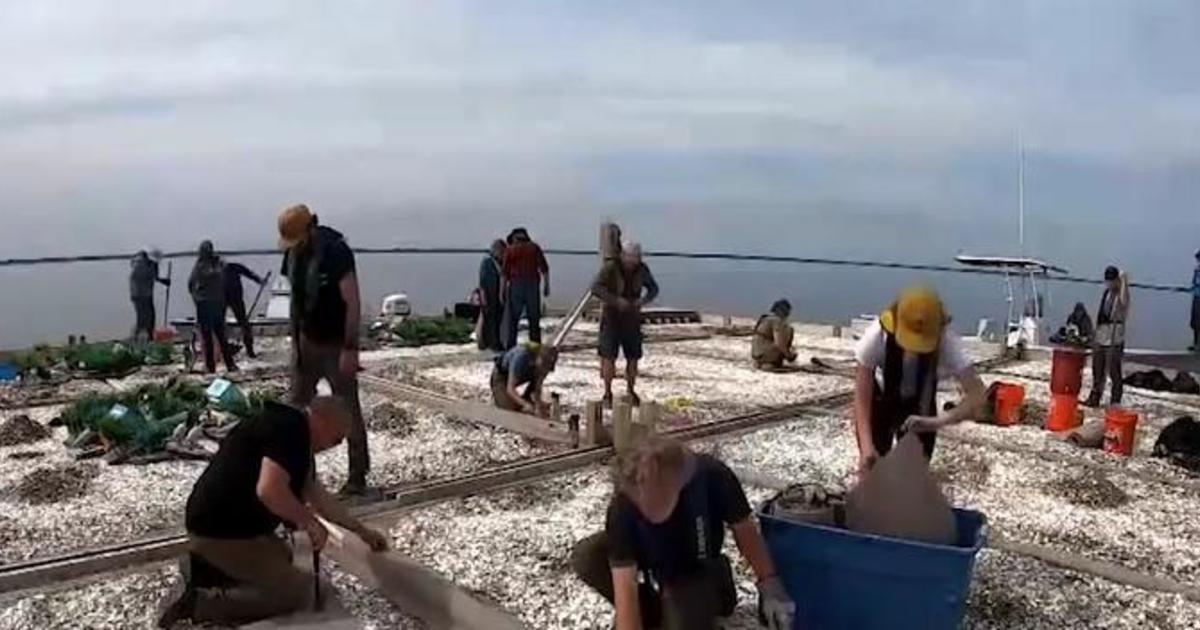Wild Divers: Searching For Chesapeake Gold
By KATIE WILLIS
The Star Democrat of Easton
CLAIBORNE, Md. (AP) -- There is another hour before the sun rises when Derek Wilson and Nick Hargrove finish fueling up their boat, load up the empty bushel baskets and head out onto the Chesapeake Bay.
Hargrove, 29, of Wittman, is the captain of the Chelsea Leigh, and Wilson, 27, of Easton, is a professional oyster diver. Together they own Wild Divers Oyster Company, which they began this past year to distribute the wild-caught, fresh Chesapeake Bay oysters they harvest, to local restaurants.
The oyster harvesting season, which began Oct. 1, will run through March 31. Per Maryland law, watermen may begin harvesting oysters, Monday through Friday, at sunrise. Their day starts much earlier, however, to make time for fueling and loading up their workboat, as well as travel time to the location they will be harvesting that day.
Once Wilson is overboard and about 20 feet below the surface of the Bay, Hargrove and the company's assistant, Brandon Elliott, 22, of Tilghman Island, wait for full cages of oysters to sort through.
When Wilson fills up a cage with oysters, he tugs on the rope attached, which tells Hargrove he needs an empty cage. Hargrove throws him a cage and waits for another tug on the rope attached to the full cage, which indicates Wilson has found the empty cage on the Bay's floor. While underwater, Wilson drags the cage along with him, searching for oysters.
Many external conditions can affect Wilson's ability to easily find and collect oysters, including tidal activity, weather, wind, water temperature and conditions found at the bottom of the different Bay locations they harvest. Hargrove said the bottom can become cloudy from Wilson dragging the cage around.
"Each bottom is different -- some are sand, some rocks, shells, mud," Hargrove said.
Also, depending on where Hargrove throws the empty cage for Wilson, it can become cloudy, making it difficult for Wilson to find the cage. He said Wilson may even need to come to the surface and follow the rope back down to the empty cage if he is unable to find it. One of Hargrove's jobs is to make sure Wilson's job is executed as easily as possible.
"You don't want your diver to have to search for the cage," Hargrove said. "But a good diver has self awareness and knows where they are on the bar. Oyster beds aren't everywhere -- there's little veins here and there."
If Wilson has to come up to the surface and dive back down frequently, it can cause him "to battle a lot of ear infections," Hargrove said.
"One of the biggest keys to the job is keeping your diver comfortable," Hargrove said. "I try to stay far enough away (in the boat) to stay out of his sun, so he can see, but close enough that I know if something happens to him."
He said hot and cold water lines allow Wilson to regulate his body temperature while underwater -- water temperatures currently are in the mid-50s -- and a larger face mask with lights allows Wilson to see better underwater.
After Wilson fills a cage with oysters, Hargrove pulls it up onto the boat's culling table, and he and Elliott remove empty shells; remove extra shells and rocks that have become attached to the oysters' outer shells; and make sure the oysters are the minimum regulation size of 3 inches or more, per Maryland law.
The process takes place again and again until they fill 30 bushels, which takes about three to five hours. Wilson is typically underwater the entire time. Per Maryland law, each oyster license allows for 15 bushels of oysters and only two licenses may be used, per boat.
By the time they are finished filling 30 bushels, they still have to deliver them to Bay Hundred Seafood and local restaurants. Wilson said an average work day is about 10 to 12 hours.
They will lose a lot of workable hours by the middle of the season, Wilson said. Per Maryland law, harvesting oysters may take place only between the hours of sunrise and 3 p.m.
"It's close to 8 a.m. before we can start in the winter," Wilson said. "Due to the loss of an hour (with the end of Daylight Savings Time) and the sun rising later and later during the winter."
Hargrove said they have been lucky to harvest their limit this season and are getting $40 per bushel.
Hargrove and Wilson have been friends since sixth grade and have worked together, intermittently, for nearly 10 years.
Wilson grew up on Tilghman Island. His grandfather dove for oysters, and his father, Greg, is a master diver. Wilson's father taught him to dive for oysters when he was 17 and currently is training Wilson's 21-year-old brother, Daniel, to do the same. While his brother is still in training, Wilson holds a unique title in the diving community.
"I'm the youngest diver out here," Wilson said.
Wilson said he does not know when he will give up diving for oysters and said he knows a number of watermen in their 50s who still are diving.
In addition to diving, Wilson sometimes shucks scallops during the spring and crabs using trotline during the summer.
Wilson left the water shortly after turning 21 and worked as a bar manager for a local St. Michaels restaurant for five years. Each winter, he returned to the Chesapeake Bay to harvest oysters; sometimes diving and sometimes dredging.
Three years ago, Hargrove, who was ready to get back out on the water after starting a company with his brother, Matt, approached Wilson with an offer.
"I said, `If you want to go diving, I'll get a boat,"' Hargrove said. "It didn't take too much to convince him."
A month before the 2014 oyster season, their first season together, the boat's engine blew up.
"It was two weeks before my wedding. He was the best man, and I was going on my honeymoon and wasn't going to be back until two days before the season started. Those were tense times with a lot of unknowns," Wilson said.
Hargrove took the engine to Virginia Beach, where the engine was rebuilt in one week.
"We didn't even get a chance to test it out," Hargrove said. "We just put it in and hoped it would work."
Wilson said it was already dark, and the evening before the start of the 2014 oyster season, by the time they put the engine in their "rig," started the boat up and navigated it to the landing they would be leaving from a few hours later.
Hargrove said each waterman's "rig," or workboat, is unique.
"You can't really go to the store and buy a rig," Hargrove said. "Every rig is different -- no two are the same."
The rig is just a boat without the other necessary equipment used to harvest oysters and everything else has to be "rigged up," Hargrove said, including an air compressor to supply air to the diver underwater and a "home-rigged" furnace that provides the diver with hot water to regulate his body temperature underwater.
Despite all the hard work and long hours, Wilson and Hargrove said they cannot think of anything they would rather do to make a living.
"I love diving. It's probably my favorite thing to do. And I get to work with my best friend every day, see the sunrise. It's awesome," Wilson said.
Wild Divers oysters are available at The Bartlett Pear in Easton, Mason's in Easton, Bistro St. Michaels, Theo's Steaks, Sides and Spirits in St. Michaels, Ava's Pizzeria and Wine Bar in St. Michaels and Carpenter Street Saloon in St. Michaels.
(Copyright 2015 by The Associated Press. All Rights Reserved.)



